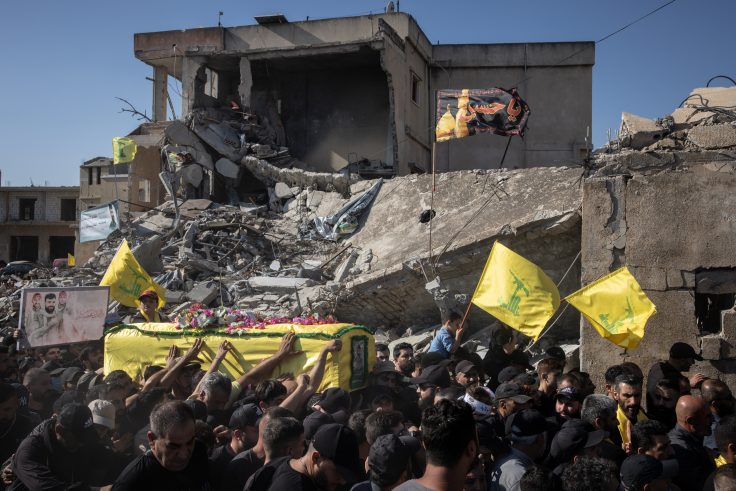Israel has destroyed scores of Hezbollah missiles, drones, and rocket launchers across Lebanon over the past several days, orchestrating an unprecedented series of pinpoint airstrikes and intelligence-driven operations that have quickly degraded swaths of the terror group's arsenal—and eliminated at least three of the group's senior commanders.
Israel's air force is pummeling Hezbollah's arms depots and targeting its senior leadership, marking the "most extensive" strikes "ever carried out in its history," according to the country's military leaders and regional news outlets.
Hezbollah, long known as Iran's preeminent regional terror proxy, is being defanged by the Jewish state's armed forces in the process. It has lost almost half of its medium and long-range missiles in a series of Israeli raids designed to annihilate "surveillance equipment, command rooms, and other infrastructure" used by Hezbollah to rain terror on Israel's northern border.
On Wednesday, Israel continued its offensive, showing no signs of backing down from a fight that it largely avoided for months as it turned its attention to Hamas in the wake of the Oct. 7 terror spree. Around 60 key targets belonging to Hezbollah's "intelligence division" were struck across Lebanon, with Israeli military leaders promising to destroy "all of their rocket capabilities" and bases.
All told, Israel has logged close to 3,000 flight hours, using more than 250 warplanes to drop an estimated 2,000 munitions across 200 separate locations in Lebanon, the Israel Defense Forces confirmed to the Washington Free Beacon. The strikes have destroyed around 400 medium-range rocket launchers, 70 weapons storage depots, and around 80 drones and cruise missiles. They've also killed at least three senior commanders—rocket and missile division head Ibrahim Qubaisi, military operations head Ibrahim Aqil, and training unit head Ahmed Wahbi—along with other top fighters.
The coordinated attacks, Israel says, are "changing the operational situation in the north, changing the reality," for Hezbollah as the terror group goes on defense after nearly a year of nonstop terror strikes on Israeli towns throughout the country. The ongoing aerial assault is being viewed as a regional game changer, proving to Hezbollah that it is not as untouchable as its leaders once believed.
Still, experts who spoke to the Free Beacon emphasized that Israel has a long way to go in its bid to defeat the terror group.
Hezbollah has missiles "dispersed and buried" across Lebanon, said David Schenker, the State Department's former assistant secretary for Near Eastern Affairs.
"They still have capabilities, and I think that they always manage to surprise," he said. "There's no knockout blow here."
At the same time, there's "still a long way Israel can go up the escalation ladder," Richard Goldberg, a former White House National Security Council member, told the Free Beacon. The Jewish state, for example, is reportedly readying a full-blown ground invasion into Lebanon after a Hezbollah missile attack targeted Tel Aviv for the first time in the conflict on Wednesday. Lt. Gen. Herzi Halevi, the Israeli military's chief of staff, reportedly told forces stationed along the northern border "to prepare the terrain" for a possible ground incursion.
For Goldberg, Israel's actions leading up to the potential invasion have helped provide a strategic advantage.
"Israel is finally committed to climbing the escalation ladder until its primary objective is achieved: the return of 60,000 civilians to their homes," Goldberg said. "Israel has disrupted communications, eliminated key leadership assets, degraded command and control, and is now working through every target in the bank to degrade Hezbollah's strategic capabilities."
Israel's airstrikes kicked off last week, shortly after the country launched a devastating surprise attack on Hezbollah's communications infrastructure. Pagers and handheld radios across Lebanon, Syria, and Iraq simultaneously detonated, sidelining an estimated 1,500 Hezbollah fighters, according to Times of Israel military reporter Emanuel Fabian.
Israel is particularly interested in Hezbollah's massive cache of sophisticated Iranian missiles and drones, which the terror group has relied on in recent weeks to strike deeper and deeper into the Jewish state's territory.
Many of these sites are located in civilian homes and areas, a tactic employed by Hamas and Hezbollah to maximize casualties. Lebanese authorities say that more than 600 have been killed—the highest casualties since Israel's 2006 war on Hezbollah—with Israel assessing that "many Hezbollah operatives are among the dead."
Over the weekend, as Hezbollah launched hundreds of missiles at Israel, the Jewish state's air force published dramatic footage of planes hitting approximately 180 of the terror group's missile launchers.
Hezbollah's command structure has also taken an unprecedented hit, with Israel in recent months assassinating 16 of the group's top leaders, including some who have been eluding authorities for decades due to their role in international terror attacks.
Those leaders include Aqil, the head of Hezbollah's operations unit and its elite Radwan Forces. Aqil was killed last week during an airstrike that also eliminated scores of Radwan fighters. Israel also killed Fuad Shukr, Hezbollah's highest-ranking military commander, in July.
These operations, however, have come with repercussions, as Hezbollah unleashes some of its most advanced missiles to strike as far south as Tel Aviv.
The terror group has launched nearly 10,000 attacks on Israel since the war began, using cruise missiles and armed drones to burn almost 200 million square meters of land.
